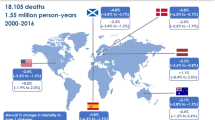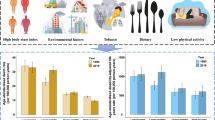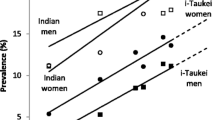Abstract
Objectives
Annual mortality of endocrine and metabolic diseases (EMD) in a population reflects levels of economy-related lifestyles and medical care, both of which have changed substantially in China in the last hundred years. Linking these two factors with historical trends of EMD will enhance our understanding of the EMD epidemiology.
Methods
Age-specific annual mortality rates of EMD from 1991 to 2016 were derived from the Health Statistics Yearbook of China and analyzed by rural and urban using age-period-cohort (APC) method. Intrinsic estimator was performed for parameter estimation.
Results
The data fit APC models well. After controlling the influence of age, the estimated period effect increased rapidly from 1991 to 2001 before it leveled off. The risk for urban area increased faster than for rural area before 2006. Contrarily, the estimated cohort effects across 100 years from 1911 to 2016 showed an overall declining trend. For urban area, the cohort effect declined progressively since the 1911–1915 birth cohort with small fluctuations, while the same effect for rural area increased slowly from the 1911–1915 cohort to the 1951–1956 cohort before it declined, intercepting twice with that of urban one at cohort 1941–45 and another at 1996–2000.
Conclusion
Increases in EMD mortality in China since 1991 can be explained primarily by the period effect, reflecting unhealthy lifestyles adapted along with rapid economic growth. The 100-year declines in cohort effect and the rural-urban differences could be largely attributed to the overall progress and rural-urban inequity in medical and healthcare. Future public health planning and decision-making must emphasize these two factors.




Similar content being viewed by others
References
Bilbao JM, Schmidt RE. Peripheral neuropathy and the role of nerve biopsy. In: Bilbao JM, Schmidt RE, editors. Biopsy Diagnosis of Peripheral Neuropathy. Cham: Springer International Publishing; 2015. p. 1–20.
Brandt F, Thvilum M, Almind D, Christensen K, Green A, Hegedus L, et al. Morbidity before and after the diagnosis of hyperthyroidism: a nationwide register-based study. PLoS One. 2013;8(6):6.
Pelletier C, Dai S, Roberts KC, Bienek A, Onysko J, Pelletier L. Diabetes in Canada: facts and figures from a public health perspective. Chron Dis Inj Can. 2012;33(1):53–4.
Watanabe H, Obata H, Watanabe T, Sasaki S, Nagai K, Aizawa Y. Metabolic syndrome and risk of development of chronic kidney disease: the Niigata preventive medicine study. Diabetes-Metab Res Rev. 2010;26(1):26–32.
Yilmaz MB, Guray Y, Guray U, Biyikoglu SF, Tandogan I, Korkmaz S. Metabolic syndrome increases the risk of significant coronary artery involvement in patients with peripheral artery disease. Coron Artery Dis. 2006;17(6):529–32.
Ng M, Fleming T, Robinson M, Thomson B, Graetz N, Margono C, et al. Global, regional, and national prevalence of overweight and obesity in children and adults during 1980-2013: a systematic analysis for the global burden of disease study 2013. Lancet. 2014;384(9945):766–81.
Commission Nhafp. China health statistics yearbook 2017. Beijing: China Union Medical University Press; 2004.
Ma RCW, Lin X, Jia WP. Causes of type 2 diabetes in China. Lancet Diabetes Endocrinol. 2014;2(12):980–91.
Peters JC, Wyatt HR, Donahoo WT, Hill JO. From instinct to intellect: the challenge of maintaining healthy weight in the modern world. Obes Rev: Off J Int Assoc Study Obes. 2002;3(2):69–74.
Healy GN, Dunstan DW, Salmon J, Cerin E, Shaw JE, Zimmet PZ, et al. Breaks in sedentary time - beneficial associations with metabolic risk. Diabetes Care. 2008;31(4):661–6.
Shen J, Goyal A, Sperling L. The emerging epidemic of obesity, diabetes, and the metabolic syndrome in China. Cardiol Res Pract. 2012;2012:178675.
Yip WCM, Hsiao WC, Chen W, Hu SL, Ma J, Maynard A. Early appraisal of China's huge and complex health-care reforms. Lancet. 2012;379(9818):833–42.
Liu Q, Wang B, Kong YY, Cheng KK. China's primary health-care reform. Lancet. 2011;377(9783):2064–6.
Hesketh T, Zhu WX. Health in China - from Mao to market reform. Br Med J. 1997;314(7093):1543–5.
Kupper LL, Janis JM, Karmous A, Greenberg BG. Statistical age-period-cohort analysis - a review and critique. J Chronic Dis. 1985;38(10):811–30.
Lee WC, Lin RS. Autoregressive age-period-cohort models. Stat Med. 1996;15(3):273–81.
Bao PP, Zheng Y, Wu CX, Huang ZZ, Gao YT, Jin F, et al. Cancer incidence in urban Shanghai, 1973-2010: an updated trend and age-period-cohort effects. BMC Cancer. 2016;16:10.
Li Z, Wang PG, Gao G, Xu CL, Chen XG. Age-period-cohort analysis of infectious disease mortality in urban-rural China, 1990-2010. Int J Equity Health. 2016;15:9.
Keyes KM, Utz RL, Robinson W, Li GH. What is a cohort effect? Comparison of three statistical methods for modeling cohort effects in obesity prevalence in the United States, 1971-2006. Soc Sci Med. 2010;70(7):1100–8.
Yang Y, Schulhofer-Wohl S, Fu WJJ, Land KC. The intrinsic estimator for age-period-cohort analysis: what it is and how to use it. Am J Sociol. 2008;113(6):1697–736.
Kramer MR, Valderrama AL, Casper ML. Decomposing black-white disparities in heart disease mortality in the United States, 1973-2010: an age-period-cohort analysis. Am J Epidemiol. 2015;182(4):302–12.
Bao PP, Zheng Y, Gu K, Wang CF, Wu CX, Jin F, et al. Trends in childhood Cancer incidence and mortality in urban Shanghai, 1973-2005. Pediatr Blood Cancer. 2010;54(7):1009–13.
Barber SL, Huang BB, Santoso B, Laing R, Paris V, Wu CF. The reform of the essential medicines system in China: a comprehensive approach to universal coverage. J Glob Health. 2013;3(1):9.
Guo Y, Bai J, Na HY. The history of China's maternal and child health care development. Semin Fetal Neonatal Med. 2015;20(5):309–14.
EBoHEoPMoPsRo C. Historical experience of preventive medicine of People's Republic of China vol. 4. Beijing: People's Medical Publishing House; 1990.
HM H. The interaction of epidemics and the public system in Republic of China. Huazhong Normal University; 2012.
Liu YL, Hsiao WC, Eggleston K. Equity in health and health care: the Chinese experience. Soc Sci Med. 1999;49(10):1349–56.
Bloom G, Gu XY. Health sector reform: lessons from China. Soc Sci Med. 1997;45(3):351–60.
Gao J, Qian JC, Tang SL, Eriksson B, Blas E. Health equity in transition from planned to market economy in China. Health Policy Plan. 2002;17:20–9.
Chen X, Wang P. Social change and national health dynamics in China. Chin J Popul Sci. 2014;2:63–73.
Blumenthal D, Hsiao W. Lessons from the East - China's rapidly evolving health care system. N Engl J Med. 2015;372(14):1281–5.
May AM, Struijk EA, Fransen HP, Onland-Moret NC, de Wit GA, Boer JMA, et al. The impact of a healthy lifestyle on disability-adjusted life years: a prospective cohort study. BMC Med. 2015;13:9.
Hu FB, Liu Y, Willett WC. Preventing chronic diseases by promoting healthy diet and lifestyle: public policy implications for China. Obes Rev. 2011;12(7):552–9.
Acknowledgments
We thank city and local health departments for reporting endocrine and metabolic diseases mortality to CDC.
Author information
Authors and Affiliations
Contributions
Study and design: all authors.
Acquisition, analysis, or interpretation of data: Ying Li and Qi Pan.
Drafting of the manuscript: all authors.
Critical revision of the manuscript for important intellectual content: all authors Statistical analysis: Ying Li, Lixin Guo, and Hong Yan.
Administrative, technical, or material support: all authors.
Study supervision: all authors.
Corresponding authors
Ethics declarations
Conflict of interest
The authors declare that they have no conflict of interest.
Additional information
Publisher’s note
Springer Nature remains neutral with regard to jurisdictional claims in published maps and institutional affiliations.
Rights and permissions
About this article
Cite this article
Li, Y., Pan, Q., Gao, M. et al. Secular trends and rural-urban differences in endocrine and metabolic disease mortality in China: an age-period-cohort modeling of National Data. Int J Diabetes Dev Ctries 40, 422–430 (2020). https://doi.org/10.1007/s13410-020-00803-w
Received:
Accepted:
Published:
Issue Date:
DOI: https://doi.org/10.1007/s13410-020-00803-w




